Taiwanese cabbage 高麗菜 is the perfect ingredient for a quick and easy side dish! With just a few simple seasonings, you'll have a mouthwatering stir-fry vegetable in under 15 minutes. The sweet and crisp cabbage leaves are a must-try.
I'll walk you through how to pick the best cabbage and an easy way to cook it so you'll have tender yet crisp cabbage that's savory and sweet with a little spice.

jump to:
✨ why you'll love this recipe
This stir-fried Taiwan cabbage recipe is flavorful and takes very little effort to make. One of the beautiful things about this particular type of cabbage is that it cooks really quickly, and cooking it only makes it better.
When you stir-fry it in a well-seasoned wok over high heat, you infuse the dish with a delicious wok aroma known as the “breath of the wok” 鑊氣 huò qì (also known as “wok hay” in Cantonese). “Qì” or “hay” means “energy” or “life breath.” I would describe the aroma as a hint of smoky flavor that brings life to the dish.
Using a well-seasoned cast iron pan would be the next best thing. Regardless of the type of pan you use, it'll be tender with a satisfying crisp (as long as it's not overcooked).
If you’re looking for other kinds of vegetable-based side dishes, you might enjoy my quick water spinach recipe, stir-fry spinach, or purple daikon recipe. Or, pair this stir-fried cabbage with a quick silken tofu dish or Chinese meatball soup for a filling afternoon pick-me-up.
💭 what is Taiwanese cabbage?
Taiwanese cabbage 高麗菜 (ko-lê-chhài in Taiwanese, or gāolí cài in Mandarin, Chinese) is a delicious, and often under-used, variety of cabbage. It's known as “flat cabbage” since it has a flat and oblong shape and is sometimes mistakenly referred to as Chinese cabbage.
It has loosely packed leaves that are crisp and tender with a sweet flavor that lacks the bitterness often found in other cabbage. It can be enjoyed raw or cooked, and thankfully, it’s in season year-round!
did you know? - This particular cabbage is used to make Taiwanese pickled cabbage. It’s typically enjoyed as street food alongside fried stinky tofu from night markets.
You can find this cabbage in well-stocked Taiwanese or Chinese grocery stores like 99 Ranch Market, usually displayed in the refrigerated produce area. I’ve also seen it at local farmers markets and online at Weee! (affiliate link).
📋 key ingredients
Taiwanese cabbage has crisp leaves and sweetness that is only enhanced by stir-frying, so there aren’t any superfluous ingredients in this recipe. The cabbage and the flavors that evolve when it’s stir-fried speak for itself.
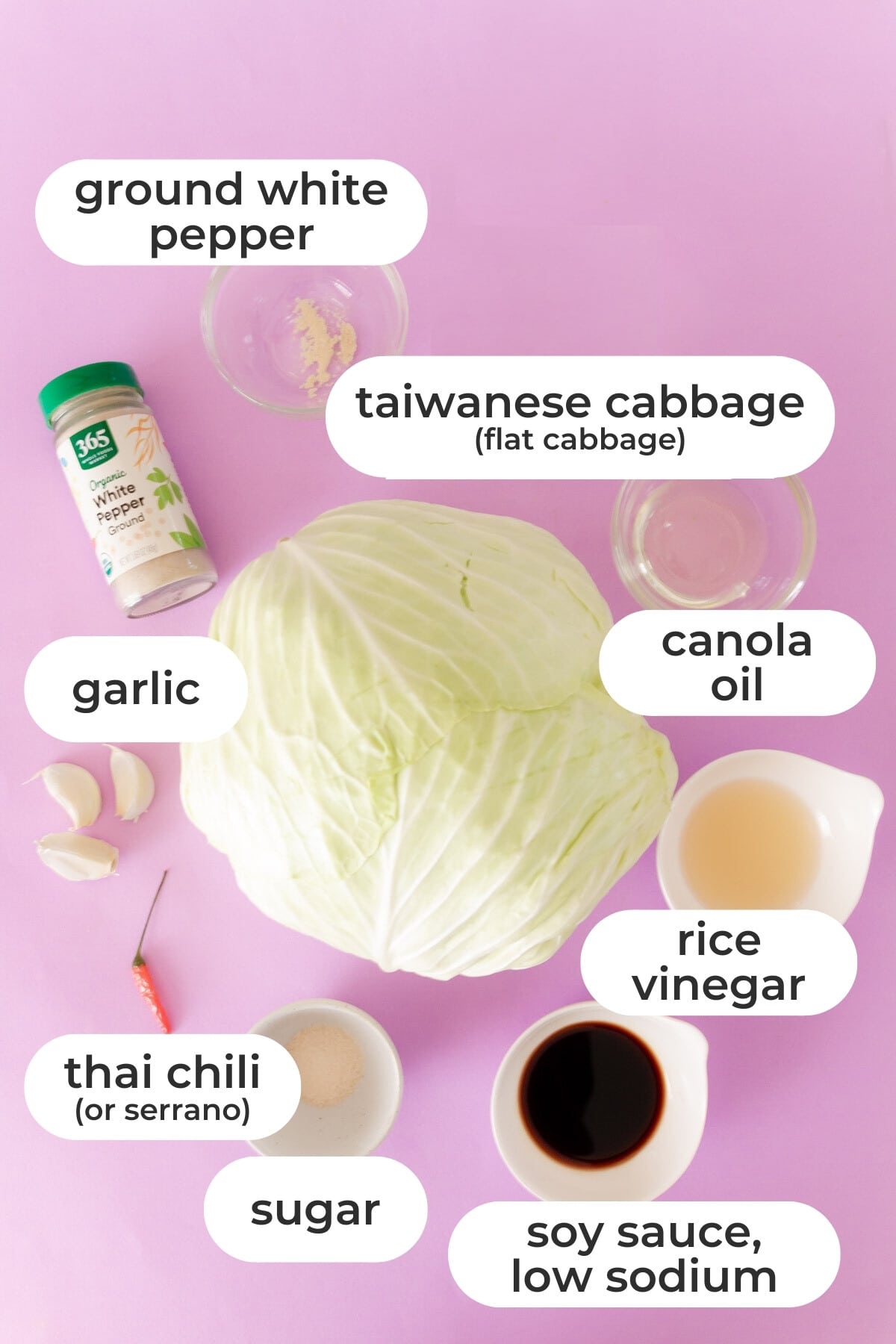
- Taiwanese cabbage - see tips on picking the best cabbage below. You can find it in well-stocked Taiwanese or Chinese grocery stores like 99 Ranch Market, usually displayed in the refrigerated produce area. I’ve also seen it at local farmers markets and online at Weee! (affiliate link) and Asian Veggies (delivers in NYC, NJ, and Long Island).
- canola oil - or another neutral flavor oil with a higher smoke point like avocado oil, peanut oil, grapeseed oil, etc.
- rice vinegar - an everyday rice vinegar would work. I use the Marukan brand in this recipe.
- soy sauce - low sodium
- ground white pepper - a signature ingredient in many Taiwanese recipes. Dishes don't taste the same when it's left out but feel free to use less to make this dish more kid-friendly.
- sugar - added to balance out the vinegar, making this dish sweet, savory, and a little spicy.
- Thai chili - fresh Thai chili is flavorful and adds a subtle spice to this dish. The next best substitute would be a small amount of serrano pepper.
See the recipe card for quantities.
🌱 how to pick Taiwanese cabbage

- feel the weight - heavier cabbages will taste better.
- check the leaves - look for crispy outer leaves that are green and tightly wrapped.
- avoid - leaves that have turned yellow along the edges, or have a bunch of holes from insect bites all the way through (it’s okay if there are just a few on the outer leaves).
- look for - a hydrated stem without cracks or mold spots.
📖 substitutions
- green cabbage - You can substitute green cabbage in for Taiwanese cabbage, but it will have a slightly more peppery flavor profile, though it will sweeten up as you cook it. Its leaves are also generally thicker, denser, and more rubbery than Taiwanese cabbage.
- napa cabbage - sometimes also called Chinese cabbage, this is an easy swap. Keep in mind that the texture and taste are different than Taiwanese cabbage, but will still taste good in this recipe. The leaves won't be crisp when cooked, but softer with a different kind of sweetness.
See the top 12 cabbage substitutes where I include an infographic that shows each one and how to cook them.
📖 variations
- simple - Taiwanese cabbage tastes just as good when stir-fried with just garlic, salt, and a sprinkle of ground white pepper. You can give that a try for a super quick and easy vegetable side dish. This is also how I like to cook it before adding it to soups like sesame oil chicken soup or instant ramen.
- pork - Stir-fry your cabbage with just a little bit of chopped bacon to enhance the flavor.
- deluxe - add in trumpet or shiitake mushrooms, shrimp, additional vegetables, or more!
🔪 instructions
I’m going to go through each step in detail below, including step-by-step photos of how to cut Taiwanese cabbage. In a hurry? You can jump straight to the printable recipe.
Here's how to easily cut a head of cabbage. For this recipe, you'll likely only be using half of one head. The other half can be wrapped in plastic wrap and stored in the refrigerator for another meal.

Place the cabbage stem side down on the cutting board and cut it in half.

Place the flat side of the cabbage - pictured here - flat on the cutting board.

Cut the cabbage into quarters.

Cut out the stem portions from each quarter piece and discard.
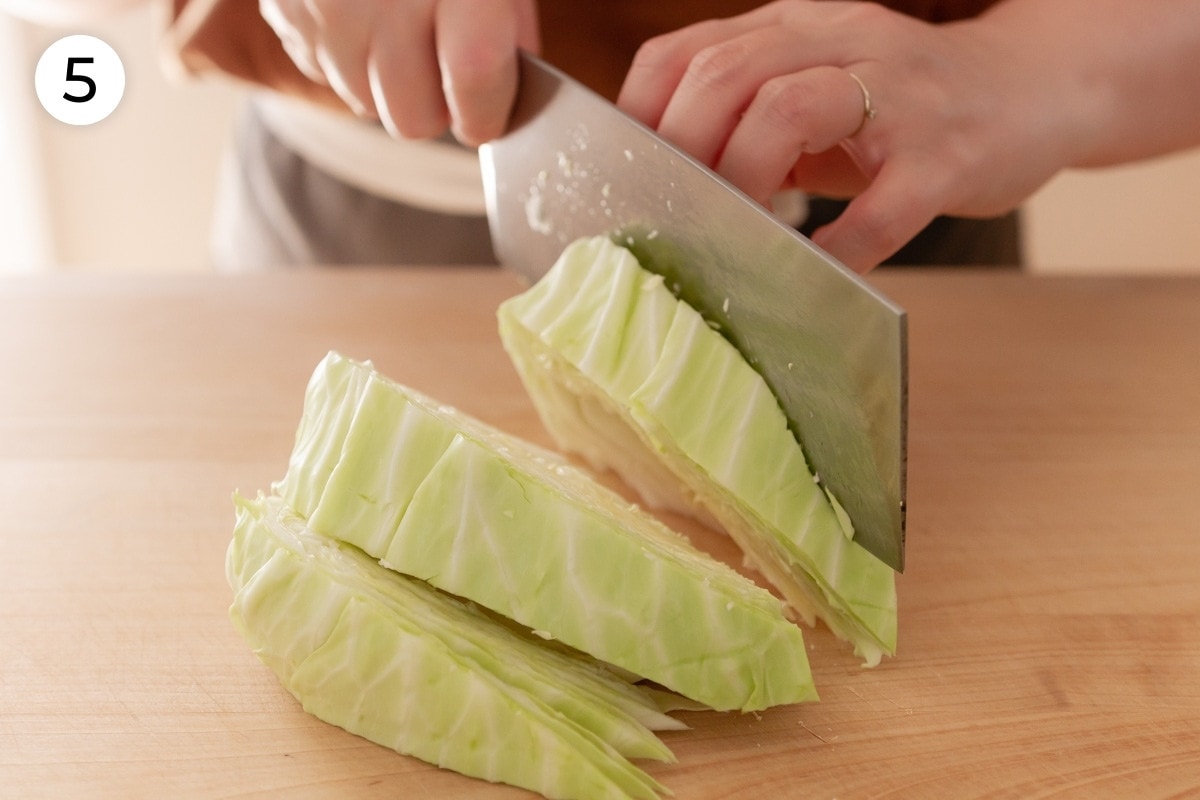
Slice the remaining cabbage head.
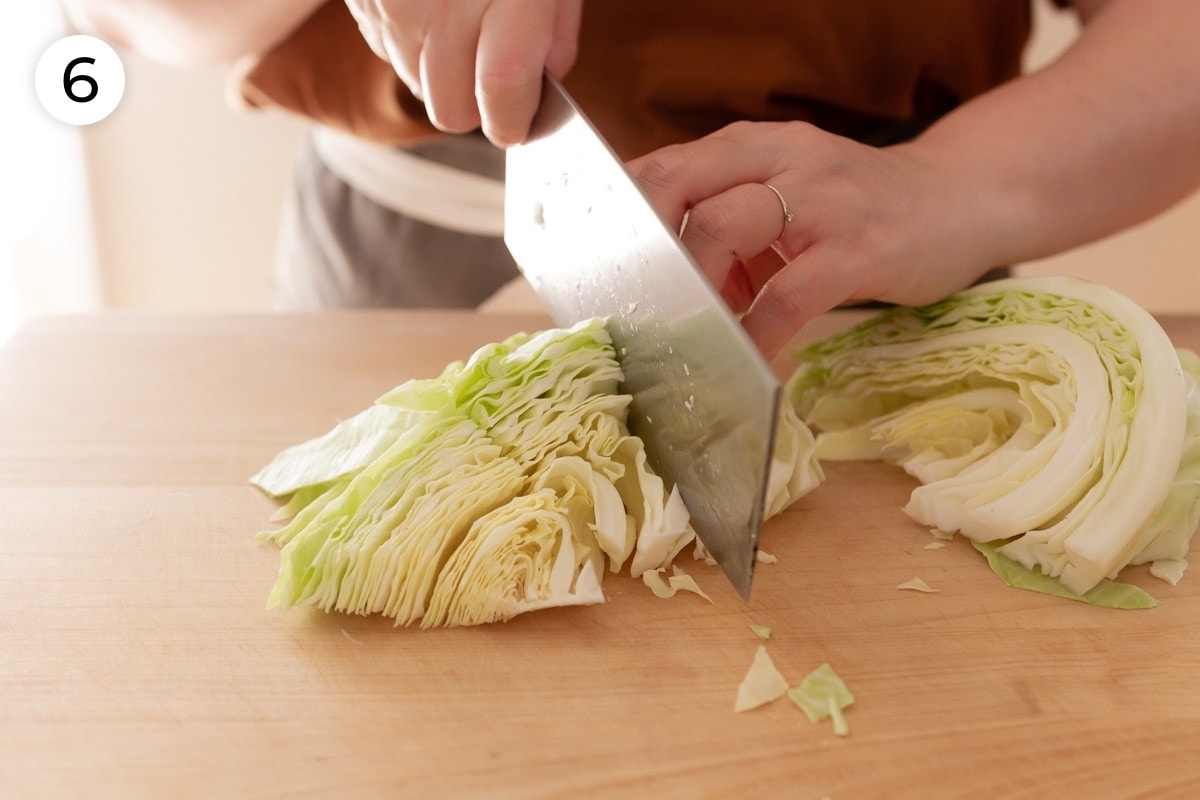
Roughly cut the leaves into 1-inch wide pieces.
Hint: Don't skip removing the stem/core portions of the cabbage. It's too tough for stir-frying as large pieces, but you can thinly slice them if you'd like to reduce waste.

Add canola oil to a 14-inch seasoned wok or cast iron pan.

Heat the wok or pan over medium-high heat until the pan is hot and just starts to smoke (about 15 seconds for a wok or 3 minutes for a cast iron pan).

Add the cabbage to the wok.

Stir-fry by constantly flipping and moving the cabbage in the wok/pan with a spatula, until it has slightly wilted and some edges have charred.

Add the minced garlic and Thai chili pepper. Stir for about 5 seconds until the garlic is fragrant.

Add the rice vinegar.

Add low-sodium soy sauce.

When the leaves are fully wilted and slightly translucent (about 2-3 minutes), season with ground white pepper.

Add sugar while you continue to toss the cabbage with your spatula.
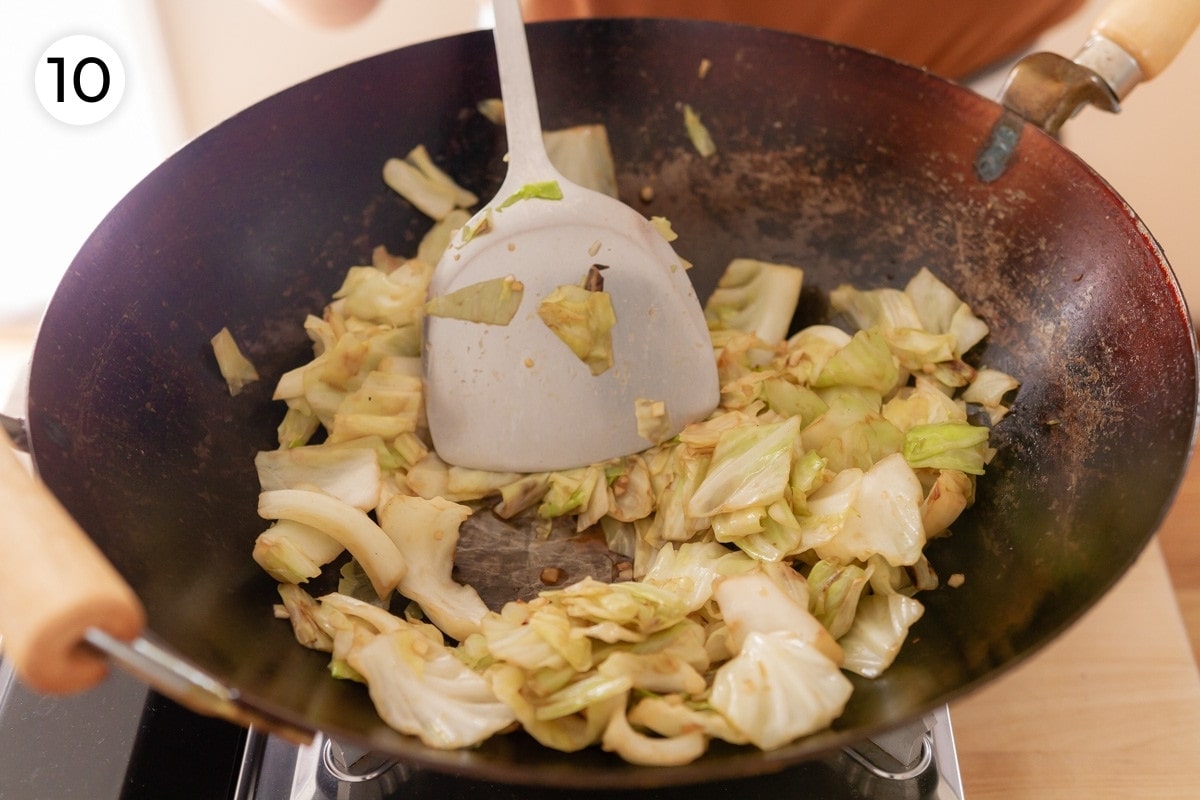
Once mixed, immediately turn off the heat. Transfer cabbage to a serving platter and serve hot as a side dish.
pro tip: Taiwanese cabbage - and even green cabbage - taste so much sweeter when stir-fried, sautéed, roasted, or grilled. That's why I always give it a quick stir-fry in a hot wok or cast iron pan even when adding to soups.
🍲 equipment
Note: Some of the links below are affiliate links, which means we do make a small profit from your purchases (your price is not affected by this commission). We are a participant in the Amazon Services LLC Associates Program, an affiliate advertising program designed to provide a means for us to earn fees by linking to Amazon.com and affiliated sites. If you click on an affiliate link, you consent to a cookie being placed on your browser for purposes of tracking commissions.
All you’ll need are a few pieces of equipment for this simple recipe! You’ll probably already have these in your kitchen, but if not I’ve linked to a couple of my favorites.
❄️ storage
Since cabbage is a sturdier vegetable, leftovers do quite well. Store this dish in a covered container and refrigerate for up to 3 days.
Any leftover raw cabbage can be stored in plastic wrap or in an airtight container/bag in the refrigerator. As long as the leaves stay dry, properly stored raw cabbage should last for a few weeks or longer.
These ingredients don't stand up well to freezing since the texture of the cabbage will change.
To reheat: Microwave for 30 seconds or put it in a steamer just for 3 minutes.
💭 top expert tip
For a boost of that mouthwatering umami flavor, add rehydrated dried shiitake mushroom slices (½ ounce or ½ cup) and/or dried small shrimp (1 tablespoon) right after adding the cooking oil. Rehydrate both before using by soaking them in just boiled water and then covering them with a smaller bowl to keep them fully submerged (about 20 minutes).
Allow to fully drain before using to avoid oil splatters.

💭 faq
There are a wide variety of ways you can cook both Taiwanese and Chinese cabbage! In this recipe, we stir-fry the cabbage, which is one of my favorite ways to elicit a sweet and smoky flavor. However, you can also braise, grill, boil, steam, and sauté it!
It's commonly referred to as "flat cabbage" because of its flat and oblong shape. It's also sometimes called Chinese cabbage even though Chinese cabbage is technically different and the term can also refer to different types of cabbage.
It's all in the shape, the leaves, and the flavor. Taiwanese cabbage has lightly packed leaves and a flat, oblong shape. The flavor is sweet and the leaves are tender. Green cabbage, however, is generally spherical in shape and is less sweet and crisp since the leaves are thicker. Napa cabbage tastes and looks different than both types of cabbage.
🥬 more related
Looking for other Taiwanese and East Asian vegetables? Try these:
👨🍳 COOKING WITH KIDS
What can kid chefs help with?
- help pick out the perfect cabbage
- measuring out the seasonings
- peeling garlic
Let me know if you have any questions in the comments below.
Happy cooking! ~ Cin
Want to get recipe updates, pro cooking tips, and nutrition info on East Asian ingredients straight to your inbox? Sign up here for a free PDF with cozy soup recipes.
Please give this recipe a star rating ⭐️⭐️⭐️⭐️⭐️ if you make it. I would love to hear from you! If you have any questions at all, let me know in the comments below.
flavorful and easy taiwanese cabbage
ingredients
- 1 pound Taiwanese cabbage, outer leaves removed if needed, and roughly chopped into 1-inch pieces
- 1 tablespoon canola oil
- 3 cloves garlic, peeled and roughly minced (about 1 tablespoon)
- ½ Thai chili, stem removed, cut in half, optional
- 1 tablespoon rice vinegar
- 1 tablespoon soy sauce, low sodium
- ⅛ teaspoon ground white pepper
- ½ teaspoons sugar
*The Instacart button above is an affiliate link, which means we do make a small profit from your purchases (your price is not affected by this commission).
instructions
- Place the cabbage stem side down on the cutting board and cut in half, then cut into quarters. Cut out the stem portions from each quarter piece and discard. You will likely only use half of a whole cabbage for this recipe. The other half can be wrapped in plastic wrap and stored in the refrigerator for another meal. Roughly cut the leaves into 1-inch wide pieces.
- Heat a 12-inch seasoned wok or cast iron pan over medium-high heat until the pan is hot and just starts to smoke (about 15 seconds for a wok or 3 minutes for a cast iron pan).
- Add the canola oil followed by the Taiwanese cabbage. Stir-fry by constantly flipping and moving the cabbage in the wok/pan with a spatula, until it has slightly wilted and some edges have charred.
- Add the minced garlic and Thai chili pepper. Stir for about 5 seconds until the garlic is fragrant, then add the rice vinegar and low sodium soy sauce.
- When the leaves are fully wilted and slightly translucent (about 2-3 minutes), season with ground white pepper and sugar while you continue to toss the cabbage with your spatula. Immediately turn off the heat.
- Transfer to a serving platter and serve hot as a side dish.
equipment and highlighted ingredients
notes
1 tablespoon canola oil
1 pound Taiwanese cabbage, washed, drained, and chopped into 1-inch pieces
3 cloves garlic, peeled and roughly minced
½ teaspoon salt, Diamond Crystal kosher salt (use half the amount if using sea salt or table salt)
⅛ teaspoon ground white pepper important note on salt: if you're using table salt instead of kosher salt, make sure to cut back on the amount by half. storage:
Since cabbage is a sturdier vegetable, leftovers do quite well. Store in a covered container and refrigerate for up to 3 days. Any leftover raw cabbage can be stored in plastic wrap or in an airtight container/bag in the refrigerator. As long as the leaves stay dry, properly stored raw cabbage should last for a few weeks or longer. Reheat in the microwave for 30 seconds or in a steamer just for 3 minutes.
These ingredients don't stand up well to freezing since the texture of the cabbage will change.
🌡️ food safety
- Don't leave food sitting out at room temperature for extended periods
- Never leave cooking food unattended
- Use oils with a higher smoking point to avoid harmful compounds
- Always have good ventilation when using a gas stove, especially when cooking over higher heat.








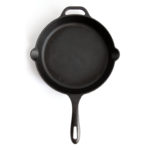



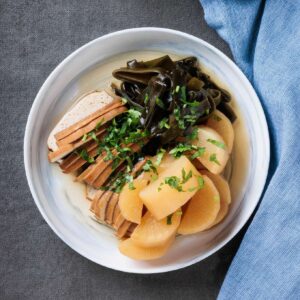



share your thoughts below. let's chat at the kitchen table: